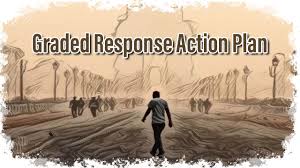Graded Response Action Plan:

The Centre’s air pollution control panel for Delhi-NCR recently directed state governments in the region to implement the first stage of the Graded Response Action Plan (GRAP).
- Graded Response Action Plan (GRAP)is a framework designed to combat air pollution in the Delhi-NCR region.
- It was introduced as an emergency response mechanism, and its implementation is triggered when the Air Quality Index (AQI) reaches “poor” levels.
- GRAP is particularly important during the winter months when air quality tends to plummet.
- The Commission for Air Quality Management (CAQM) in NCR and adjoining areas oversees the implementation of GRAP.
- It collaborates with the Ministry of Environment, Forest and Climate Change (MoEFCC).
- The CAQM has constituted a sub-committee for the operationalization of the GRAP.
- This body includes officials from the CAQM, member secretaries of pollution control boards of Uttar Pradesh, Delhi, Haryana, Rajasthan, the Central Pollution Control Board, a scientist from the IMD, one from the IITM, and a Health Advisor.
- The sub-committee is required to meet frequently to issue orders to invoke the GRAP.
- The orders and directions of the CAQM will prevailin case of any conflict between directions issued by the State governments and the CAQM.
- Different stages of GRAP: GRAP consists of four stages, each with targeted actions to be taken by the necessary authorities and agencies. These are the following:
- Stage I: “Poor” air quality (Delhi AQI: 201-300)
- Stage II: “Very Poor” air quality (Delhi AQI: 301-400)
- Stage III: “Severe” air quality (Delhi AQI: 401-450)
- Stage IV: “Severe+” air quality (Delhi AQI > 450)




